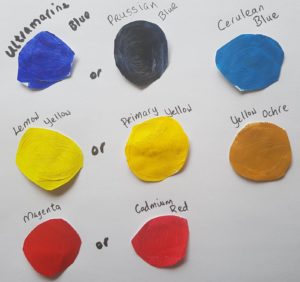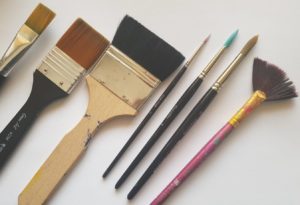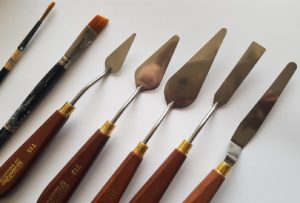Painting With Acrylics – Getting Started
Painting with acrylics need not be as confusing for beginners as it may seem. As you enter an art store, you are met with an array of paints, brushes, pads, canvases, mediums etc. For a beginner this can be overwhelming. We will break down what are the basics that you need to get started with in your artistic journey
Paint
We will limit the colour palettes. The primary colours red, blue and yellow are able to be mixed together to create all other colours. There’s a cool and warm version of each of the primaries (red, blue and yellow) which I will explain in anotther blog. For the moment get one of each primaries. See colours below

- Ultramarine Blue (warm) or Prussian Blue (cool)
- Cadmium Red (warm) or Magenta (cool)
- Primary Yellow(warm) and Lemon Yellow (cool)
- White (and lots of it!)
I am suggesting 2 other colours as well. Cerulean Blue is an excellent colour for skies and this hue is hard to achieve using either blues above. Yellow Ochre gives an more earthy colour than the above yellow hues as well and is used alot when mixing colours
Burnt Sienna or Raw Umber are 2 other colours that you might consider adding to your stock at a later stage.
Student or Artist Quality
Unlike watercolour paints, where there is still a clear definition between students and artists quality, the division with acrylics is somewhat more blurred. There is less emphasis on ‘student’ and ‘professional’ terms and more on the viscosity (thickness) of the paint. When painting with acrylics, you will tend to use alot of paint. I would suggest you use the more fluid range eg Windsor and Newton Galeria Range or Daler Rowney System 3 *. Sometimes, you actually can get good quality acrylic paints in Aldi and Lidl but ensure you are getting good sizes eg 75ml or more. Another thing to note is that these paints may not have the standard recognised hue colours on them. However when you are starting, these paints are fine as you need to practise.
Brushes
Again, I want to keep life simple. There are round, flat, fan, filberts, riggers, angled brushes and palette knives. Brushes can be made of bristle(hogs hair) or synthetic (nylon). Synthetic are more resilient and nearly as good as bristle. It is extremely important that you clean your brushes as once paint dries, the brush is useless. The following brushes are the ones I recommend

- 1/2 inch and 1 inch flat brush
- 1.5 inch flat brush (you can get these in DIY paint store as well). Useful for painting large washes
- Number 2, Number 8 and Number 12 round brushes
- 1/2 or 1 inch Fan Brush
- Palette Knife 3/4 long or a set of palette knives if you are going to experiment with impasto(palette knife) paintings

- Number 1 Rigger brush (optional) Really useful when painting a long line
- Angled Brush I found this increases accuracy when painting in curved areas
The final 2 can be optional for the moment . I found when I added these to my stock, they improved my painting skills!
Brands to look out for are Richard Oliver , Windsor & Newton Galleria or Windsor & Newton Cotman*
Paper or Canvas or What?
Acrylics can be painted on most surfaces eg paper, canvas, wood, hardboard, newspaper, wrapping paper. Canvas can become expensive if you are practising alot. A pad of acrylic paper is a good starting point. It is less costly and easier to store and also to bin it! Try and get paper that is at least 300gsm as acrylic paint can be heavy on light paper and hence it will bend or even curl! Note Canvas may need to primed before painting on it (usually using gesso).
Palette
For the moment you can just used a plate or plastic palette which can be picked up quite cheaply in any art shop or local stores that sell art supplies.
Anything Else?
- Gesso – used for priming surfaces eg canvas or boards
- Water spray – Acrylic paint can dry quickly. So this is useful to spray on the paint in your palette.
- Tissue or Kitchen Paper (plenty of it, to clean brushes)
- Jars of water (one to clean your brush and one to add water to your paint if needed)
Now you are ready to go. Good luck and enjoy your journey into this exciting world.


